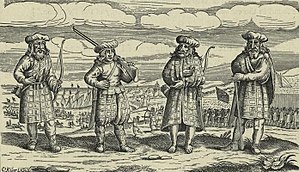
Back Kilt Afrikaans إزار إسكتلندي Arabic Kilt Azerbaijani Килт Bashkir Kilt BCL Кілт Byelorussian Kilt BJN Kilt Catalan تەنووری سکۆتلاندی CKB Kilt Czech

A kilt (Scottish Gaelic: fèileadh [ˈfeːləɣ])[1] is a garment resembling a wrap-around knee-length skirt, made of twill-woven worsted wool with heavy pleats at the sides and back and traditionally a tartan pattern. Originating in the Scottish Highland dress for men, it is first recorded in the 16th century as the great kilt, a full-length garment whose upper half could be worn as a cloak. The small kilt or modern kilt emerged in the 18th century, and is essentially the bottom half of the great kilt. Since the 19th century, it has become associated with the wider culture of Scotland, and more broadly with Gaelic or Celtic heritage.
Although the kilt is most often worn by men on formal occasions and at Highland games and other sports events, it has also been adapted as an item of informal male clothing, returning to its roots as an everyday garment. Kilts are now made for casual wear in a variety of materials. Alternative fastenings may be used and pockets inserted to avoid the need for a sporran. Kilts have also been adopted as female wear for some sports.
- ^ "Am Faclair Beag". www.faclair.com.